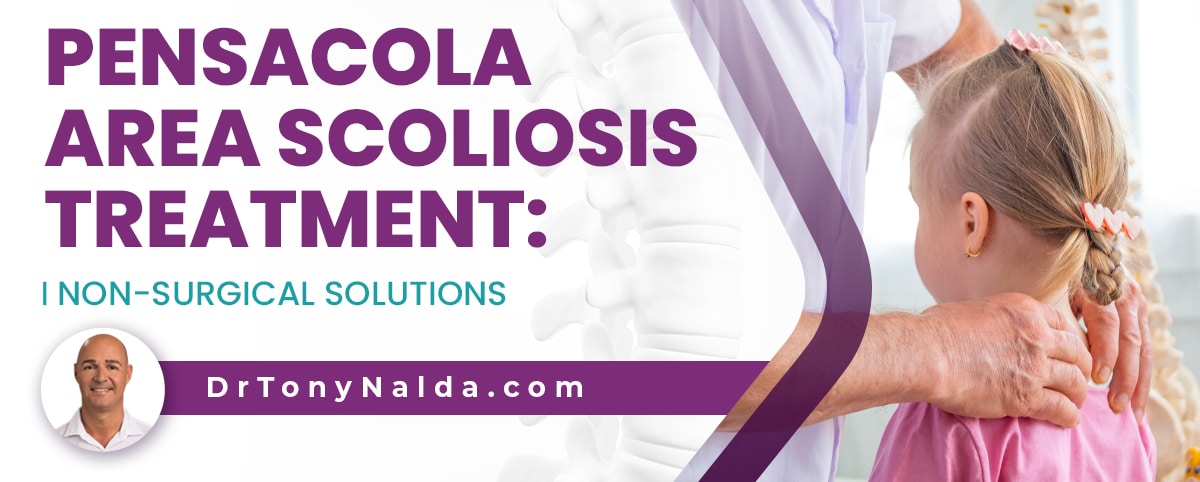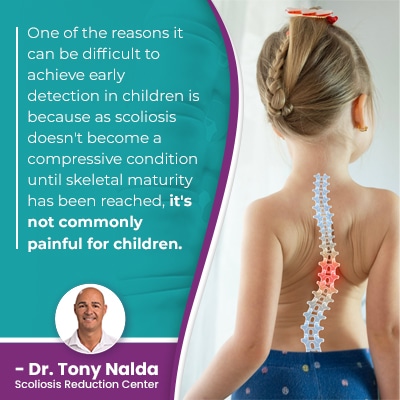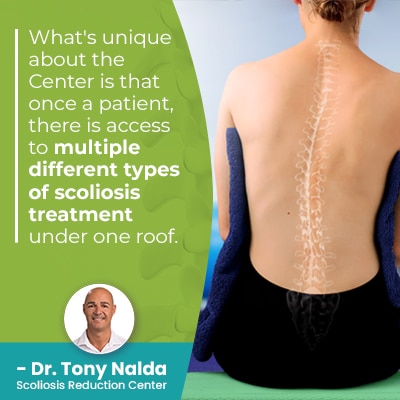Pensacola Area Scoliosis Treatment: Non-Surgical Solutions

Scoliosis treatment needs to be taken seriously; as a progressive condition, there is no curing scoliosis, but it can be highly treatable. There are no treatment guarantees, but particularly with early detection and intervention, there are fewer limits to the non-surgical scoliosis solutions I can work towards with patients of my center.
Dr. Tony Nalda, and his innovative Scoliosis Reduction Center®, are a 2-hour flight away from those in need of pensacola area scoliosis treatment. Becoming a patient of the center means accessing multiple types of scoliosis treatment under one roof.
Diagnosing scoliosis isn't always easy, so let's start with why.
Table of Contents
The Challenge of Early Detection
For anyone reading about scoliosis, the term early detection will reappear; this is because as a progressive condition, the nature of scoliosis is to get worse over time.
Early detection means a diagnosis is reached prior to significant progression having already occurred, when conditions are milder and more treatable.
The challenge of early detection is that although scoliosis can progress quickly, its signs can be subtle, and it's not uncommon that people live with scoliosis for years unaware, not becoming aware until enough progression has occurred to make its effects overt, but by this time, it's more complex to treat.
As scoliosis progresses, the spine becomes increasingly rigid, and this can make it less responsive to treatment and make it difficult for many patients to perform specific spinal exercises.
As scoliosis progresses, the condition's effects are becoming more overt, and this can make them more difficult to reverse.
As such a complex condition, it requires the complete customization of treatment plans because no two cases are the same, and while we don't often know what caused the scoliosis to develop, we know how to treat it effectively.
The benefits of early detection, however, are also only available to those who respond with a proactive treatment approach, and this is important because different treatment approaches offer different potential results.
Scoliosis ranges in severity from mild scoliosis to moderate scoliosis patients and severe to very severe cases; mild scoliosis can be difficult to detect, particularly in children.
Childhood Scoliosis and Progression
 Scoliosis is the leading spinal condition among school-aged children, and as progression is triggered by growth, childhood scoliosis always needs to be taken seriously.
Scoliosis is the leading spinal condition among school-aged children, and as progression is triggered by growth, childhood scoliosis always needs to be taken seriously.
One of the reasons it can be difficult to achieve early detection in children is because as scoliosis doesn't become a compressive condition until skeletal maturity has been reached, it's not commonly painful for children.
It's compression (uneven pressure) that causes the majority of condition-related pain, and this can involve muscle pain, back pain, and pain that radiates throughout the body due to nerve compression; pain is the main symptom that brings adults in to see me for a diagnosis and treatment options.
Scoliosis progression means the size and rotation of the unnatural sideways-bending spinal curve is increasing, as are the condition's effects.
Symptoms of Childhood Scoliosis
In children, the most noticeable symptoms of scoliosis involve postural changes caused by the condition's uneven forces disrupting the body's overall symmetry.
In many cases, the earliest signs of scoliosis in children are uneven shoulders and hips, and additional changes can include the development of a rib cage arch, uneven shoulder blades, and arms and legs hanging at different lengths.
In addition, changes to gait, balance, and coordination are also common.
Clothing can suddenly seem ill-fitting with uneven necklines and pants not sitting evenly on hips.
The most common age of scoliosis patients are adolescents between the ages of 10 and 18 diagnosed with adolescent idiopathic scoliosis, and this age group is the most at risk for rapid progression due to the rapid and unpredictable growth spurts of puberty.
When treating childhood scoliosis, a large focus of treatment is on how best to counteract the condition's progressive nature as it's constantly being triggered by growth.
When scoliosis begins in childhood, if it's not addressed during childhood, it will likely continue progressing into adulthood, when it tends to become painful and more noticeable.
Scoliosis Treatment Options
For Pensacola, FL, residents, a two-hour flight puts them within reach of leading scoliosis chiropractor, Dr. Tony Nalda, and his Scoliosis Reduction Center®.
What's unique about the Center is that once a patient, there is access to multiple different types of scoliosis treatment under one roof.
There is no driving from a chiropractor's office to a physical therapist across town, then to a different center for scoliosis bracing, etc; the Center's treatment approach is integrative so combines the power of many different types of treatment.
This multifaceted approach also allows for the complete customization of effective treatment plans by adjusting the different treatment disciplines accordingly based on a patient's individual response both to treatment and growth (childhood scoliosis).
Conservative Treatment Benefits
 A conservative approach to scoliosis treatment is proactive because it prioritizes prevention.
A conservative approach to scoliosis treatment is proactive because it prioritizes prevention.
As most cases of scoliosis have no known cause, we can't do anything to prevent their initial onset, but what we can work towards preventing is the condition's progression, and when treatment is started as close to the time of diagnosis as possible, this means when the condition is at its mildest and likely at its most responsive to treatment.
There is a surgical option to treat scoliosis, and this commonly involves spinal fusion, but this can be a costly, invasive, and risky procedure, and the truth is that many cases of scoliosis can be treated without surgery.
In order for progression to be prevented, a person has to commit to a modern conservative treatment approach that works towards controlling progression, minimizing the condition's effects, and helping patients avoid the need for spinal surgery.
Different Types of Scoliosis
Not only does scoliosis range widely in severity from mild to very severe, there are also different types of scoliosis, and type is determined by a condition's cause.
So in most scoliosis cases, approximately 80 percent are idiopathic, meaning no known cause, and the remaining 20 percent are associated with known causes: neuromuscular, degenerative, and congenital.
Scoliosis with Known Causes
With typical cases of idiopathic scoliosis, conservative treatment combines chiropractic care, physical therapy, scoliosis exercises, and rehabilitation; with atypical types with known causes, the underlying cause has to shape the treatment.
In cases of neuromuscular scoliosis, the underlying neuromuscular condition causing the scoliosis has to be the driving force of treatment: cerebral palsy, spina bifida, and muscular dystrophy, for example.
With degenerative disorders of the spine, degenerative scoliosis treatment has to focus on preserving spinal function and increasing the spine's stability, support, and balance, and this can involve gentle chiropractic care involving specific spinal adjustments and physical therapy to strengthen the spine's surrounding muscles.
Bracing for adult scoliosis can also help with short-term pain management, and the ultra-corrective ScoliBrace can help straighten lateral curves by pushing the spine into a straighter alignment so the scoliotic spine is more balanced.
While scoliosis isn't just a simple misalignment of the spine,
In cases of congenital scoliosis, it's the spine's structural malformation that has to be addressed, and this can involve surgery, observation, and/or bracing when appropriate.
Conclusion
Progressive spinal conditions need to be treated proactively, and those that are left untreated are the most likely to continue progressing, can cause complications in the future, and are also the most likely to need surgical intervention.
Rates of progression will vary, but we know children are the most likely to progress quickly and adult scoliosis gradually progresses because the trigger of growth is removed; that being said, in cases of degenerative scoliosis, once natural age-related spinal degeneration comes into play, progressive rates can increase as the spine becomes increasingly unbalanced and unstable.
Diagnosing scoliosis can involve a physical examination, taking a patient's full health history, an A dams position test, and x ray results.
Once a diagnosis is given, the most important decision to be made is how to treat the condition moving forward; surgical and non-surgical are two main treatment options, and each will shape the spine's long-term health differently.
The body's compensations can be impressive as it adjusts to the postural changes caused by scoliosis, which is why it's better to proactively work towards preventing progression and increasing condition effects than attempting to reverse effects they're established.
Pensacola fl is a mere 2-hour flight from Celebration, Orlando, and this is home of the Scoliosis Reduction Center®, where non-surgical scoliosis treatment results speak for themselves.
For those in need of a proactive non-surgical scoliosis treatment option, don't hesitate to reach out to schedule a consultation.
Dr. Tony Nalda
DOCTOR OF CHIROPRACTIC
After receiving an undergraduate degree in psychology and his Doctorate of Chiropractic from Life University, Dr. Nalda settled in Celebration, Florida and proceeded to build one of Central Florida’s most successful chiropractic clinics.
His experience with patients suffering from scoliosis, and the confusion and frustration they faced, led him to seek a specialty in scoliosis care. In 2006 he completed his Intensive Care Certification from CLEAR Institute, a leading scoliosis educational and certification center.
About Dr. Tony Nalda
 Ready to explore scoliosis treatment? Contact Us Now
Ready to explore scoliosis treatment? Contact Us Now





